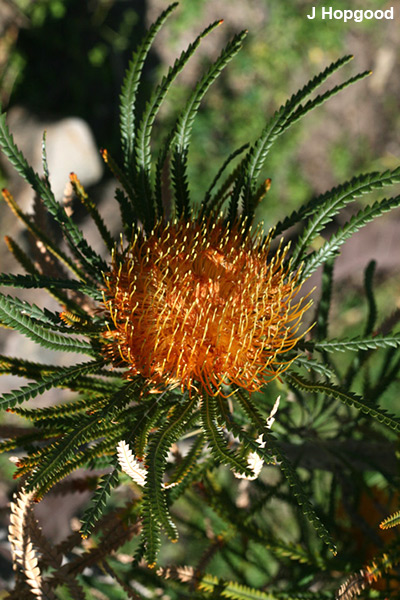General Description:
Banksia is a large genus of over 200 species in the Protea family, having been increased in size through the transfer of species in the former genus Dryandra to Banksia (see footnote box). The genus is almost exclusively Australian, being found in all States and Territories. A single species (B.dentata) is found in islands to Australia’s north as well as in tropical Australia.
Banksia formosa is well known in cultivation and is a medium to large shrub which may reach 3 metres x 2 metres (sometimes larger). The leaves are linear, 50-180 mm long by about 10mm wide and regularly toothed to the mid rib with triangular lobes. The flower clusters may be up to 100 mm in diameter and occur at the ends of the branches in spring. They are usually yellow to orange in colour and are popular as cut flowers.
B.formosa is a spectacular, fast-growing plant which will grow and flower in subtropical climates but is rarely long lived in those areas. It is better suited to temperate areas with a dry summer and it grows well in southern Victoria and South Australia. It requires well drained soils in a sunny or semi-shaded position and responds to pruning. It is also tolerant of at least moderate frost.
Propagation from seed is relatively easy and cuttings are also successful.
A paper published in 2007 proposed that the genus Dryandra be subsumed into Banksia. This revised classification has been accepted by the Council of Heads of Australasian Herbaria and the new Banksia names now appear on Florabase (the website for the Western Australian Herbarium) and in the Australian Plant Census.
The new classification has come in for some criticism but, as the Austraian Plant Census has been adopted as the authority on plant names by ANPSA, the revised classication has been accepted on the ANPSA website. The previous Dryandra names will also be mentioned where appropriate. For further information refer to our Banksia page.

Banksia formosa (syn. Dryandra formosa)
Photo: Jan Hopgood
Images of all species in the former genus Dryandra can be seen in the Dryandra Study Group’s Dryandra Image Gallery
 Australian Native Plants Society (Australia)
Australian Native Plants Society (Australia)













